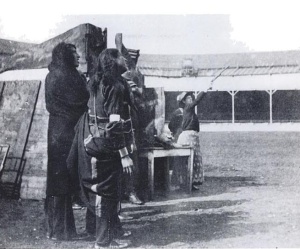Sadly, we now know London will bid farewell to the art deco façade of Earl’s Court after the 2012 Olympic Games. How many people are aware, though, that this corner of west London was making an exhibition of itself long before C. Howard Crane’s iconic building opened its doors in 1937?
In the late c19th the site on which Earl’s Court stands was compromised by railway sidings: scrubby, industrial, and fit only for the improvisations of showground entrepreneur John Robinson Whitley. Whitley put the area on the map by setting up a semi-permanent Wild West Show there, along with a forerunner to the London Eye – an observation wheel – and water features.
By 1900, now managed by Wallace Jones, the covered Exhibition and Grounds (‘buildings warmed throughout’) were staging respectable trade shows, including a predecessor of the famous boat show, where craftsmen could be watched while they constructed canoes, skiffs and ‘American motor launches.’
The pleasure park was also home to military bands and firework displays, as well as ‘the most comfortable [skating] rink in London.’
Sadly, history barely records an ambitious novelty that came to the site one summer a hundred years ago. The innovation appears to have been the brainchild of the Grounds’ new proprietor, J. Calvin Brown.
Brown bought Earl’s Court’s in 1910, determined to return it to its former glory as an amusement park. This would be no superficial tweak: he closed the space down while regenerating its charms. And he brought to bear all his experiences at other leisure centres – from White City in London to the Magic City on the banks of the Seine in Paris.
He knew he needed an exceptionally brilliant new attraction as the ultimate centrepiece at the relaunched venue. And once he had found it he told the world and, well, the excitement and anticipation was barely controllable.
‘Two minutes after the Derby is run at Epsom,’ enthused the Daily Express in April 1911, ‘the race will be repeated at Earl’s Court Exhibition on the wonderful mechanical racecourse that is being built there… ’
Sorry, did you say ‘mechanical racecourse’? The sport of kings as a fairground ride?
‘This miniature Sandown Park, with its nine mechanically-operated horses, starting gate, and realistic environment, will be the rage of London during the summer,’ cheered the Express.
The plan was that each major event in the horse-racing calendar would be re-enacted mechanically at Earl’s Court, with jockeys of both sexes mounted on the petrified thoroughbreds.
This was quite a large installation – the same size as a water chute at the same venue – with 100 yards of track on a downward slope to produce momentum after the gate was lifted.
‘Then the equestrian ability of the riders will be brought into play by a very ingenious rocking motion which almost perfectly simulates the action of a racehorse. The most vigorous rider will win the race.’
Of course Brown filled the rest of the space with fairground rides with wonderful names such as ‘Squeezers’, ‘Joy Wheels’ and ‘Dragon’s Gorge’. But it was the brilliant new mechanical racecourse that would have ‘a more sporting element attached to it than the usual side-show,’ concluded the Express.
That was the plan. Sadly, there is no further mention of horses, mechanical or otherwise. Summer 1911 advertisements for the pleasure park highlight instead a herd of performing (but non-competing) elephants. What went wrong? Did the installation suffer a Devon Loch-style disaster at the last minute? Was it even built?
What we do know is that Brown’s leisure radar was not entirely wonky. Another Englishman, J.W. Cawdry, had licensed a much larger, weaving metal track with six wooden horses to George Tilyou, impresario of the Steeplechase Park in Coney Island, Brooklyn, USA, back in 1897. Perhaps Brown had seen it for himself.
That ride successfully entertained the New York public for over seven decades before closure. Which, by sad coincidence, brings us back to the doomed Earl’s Court Exhibition Centre that Londoners know today.

